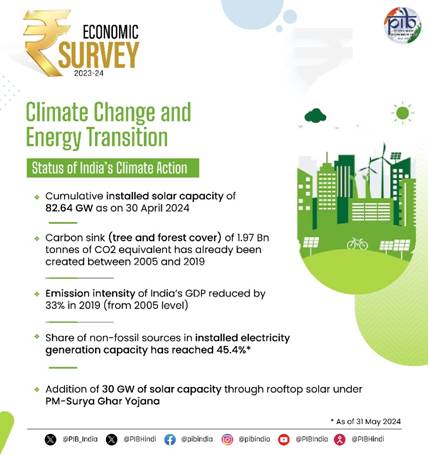Ministry of Finance
DESPITE BEING ONE OF THE FASTEST-GROWING ECONOMIES IN THE WORLD, INDIA’S ANNUAL PER CAPITA CARBON EMISSION IS ONLY ABOUT ONE-THIRD OF THE GLOBAL AVERAGE
INDIA IS THE ONLY G20 NATION IN LINE WITH 2-DEGREE CENTIGRADE WARMING: IFC REPORT
INDIA ACHIEVES ITS NDC TARGET OF REDUCING EMISSION INTENSITY 11 YEAR IN ADVANCE BEFORE THE TARGET YEAR 2030
INDIA SUCCESSFULLY DECOUPLES ITS ECONOMIC GROWTH FROM GREENHOUSE GAS EMISSIONS
MISSION LIFE: MASS MOVEMENT TO ADDRESS CLIMATE CHANGE AND FOSTER SUSTAINABLE LIVING
INDIA LEADING SEVERAL INTERNATIONAL INITIATIVES TOWARDS CLIMATE CHANGE MITIGATION AND BUILDING RESILIENCE
प्रविष्टि तिथि:
22 JUL 2024 2:21PM by PIB Delhi
Despite being one of the fastest-growing economies in the World, India’s annual per capita carbon emission is only about one-third of the global average, states Economic Survey 2023-24, which was tabled in Parliament today by Union Minister of Finance and Corporate Affairs, Smt. Nirmala Sitharaman.
Delving further into India’s achievements on addressing climate change, the Survey quoted a recent report by the International Finance Corporation, which highlighted that India is the only G20 nation in line with 2-degree centigrade warming. The survey further mentioned that the hallmark of India’s growth strategy is to manage the impact of climate change and at the same time give desired focus to developmental priorities.

Significant Progress Made by India on Climate Action
India achieved most targets of the first NDC well in advance. Nation achieved 40 per cent cumulative electrical power installed capacity from non-fossil fuel-based energy sources in 2021 and reduced the emission intensity of India’s GDP from 2005 levels by 33 per cent in 2019– nine and eleven years before the target year of 2030, respectively.
Further, as of 31 May 2024, the share of non-fossil sources in the installed electricity generation capacity has reached 45.4 per cent up from 32 per cent in April 2014. India is also on track to make an additional carbon sink of 2.5 to 3.0 billion tonnes through tree and forest cover by 2030, with a carbon sink of 1.97 billion tonnes of CO2 equivalent having already been created from 2005 to 2019.
India’s GDP between 2005 and 2019 has grown with a Compound Annual Growth Rate (CAGR) of about seven per cent, whereas the emissions grew at a CAGR of about four per cent. i.e., the rate of emissions growth is lower than the rate of growth of our GDP. This shows that India has successfully decoupled its economic growth from greenhouse gas emissions, reducing the emission intensity of its GDP.
India’s total adaptation-relevant expenditure has increased from 3.7 per cent of GDP in 2015-16 to 5.60 per cent of the GDP in 2021-2022, indicating integration of climate resilience and adaptation into development plans.
Low Carbon Development and Energy Composition
India’s energy needs are expected to grow 2 to 2.5 times by 2047 to meet a growing economy's developmental priorities and aspirations. Considering that resources are limited, the survey pointed out that the pace of energy transition would need to factor in alternative demands on the resources for improving resilience to climate change and for sustained social and economic development.
Challenges for Energy Transition and Way Forward
Highlighting various challenges to India’s development of a low-carbon path, Economic Survey mentioned that expanding renewable energy and clean fuels will increase demand for land and water. Most renewables are land-intensive and demand the highest land use requirements among the different energy sources. Further, the expansion of renewable energy requires battery storage technologies which in turn require the availability of critical minerals and the source of such minerals is geographically concentrated.
Recognising the importance of energy efficiency measures in accelerating clean energy transitions while supporting energy security, the Survey highlighted several initiatives taken by the Government to improve energy efficiency. Some of them include implementing Energy Conservation Building Code (ECBC) for buildings, Standards and Labelling (S&L) and Star-rated program for appliances, Lifestyle for Environment (LiFE) initiative for encouraging the adoption of sustainable lifestyles, Perform, Achieve, and Trade (PAT) scheme for industrial sector, and Charging Infrastructure for Electric Vehicles for transport sector, among others.
All above mentioned initiatives translates to a total annual cost savings of approximately ₹1,94,320 Crore and an annual CO2 emissions reduction of around 306 million tonnes.
Finance for Sustainable Development
The Survey outlines that country has taken many measures to improve the business environment and catalyse greater quantum of resources. The Government undertook the issue of sovereign green bonds amounting to ₹16,000 Crore in January-February 2023 to raise proceeds for public sector projects that would contribute to the efforts to reduce the intensity of the economy's emissions, followed by ₹20,000 Crore raised through sovereign green bonds in October-December 2023.
Further, RBI has implemented the Framework for Acceptance of Green Deposits for the Regulated Entities to foster and develop a green finance ecosystem in the country. In addition, the RBI promotes renewable energy through its Priority Sector Lending (PSL) rules.
India's Innovative Green Credit Program
The Survey talks about the Government of India’s Mission LiFE, which is envisaged as a mass movement to address climate change and foster sustainable living based on conservation and moderation principles. It further states that to bolster LiFE’s effort and encourage eco-friendly practices, the Government also supports voluntary environmental actions such as the Green Credit Programme (GCP), which incentivises individuals, communities, private sector industries, and companies to participate in environment-positive activities by offering green credits as rewards.
India leading International Initiatives Addressing Climate Change Issues
The survey extensively talks about India leading several international initiatives towards climate change mitigation and building resilience. The International Solar Alliance (ISA), One World, One Sun, One Grid (OSOWOG), the Coalition for Disaster Resilient Infrastructure (CDRI), the Infrastructure for Resilient Island States’ (IRIS) and the Leadership Group for Industry Transition (LeadIT) are some of such important examples.
******
NB/SNC/HP
(रिलीज़ आईडी: 2034915)
आगंतुक पटल : 7395